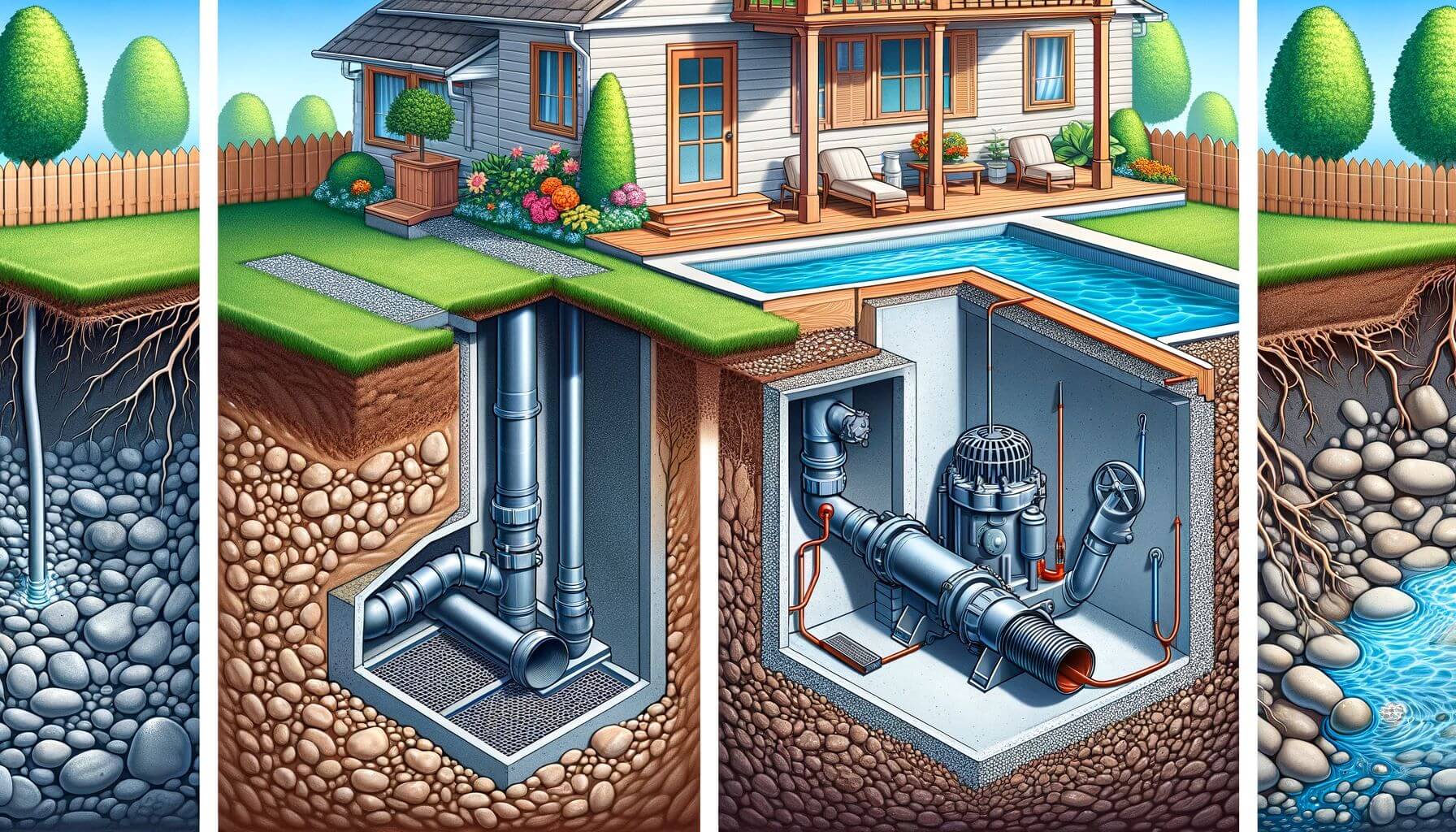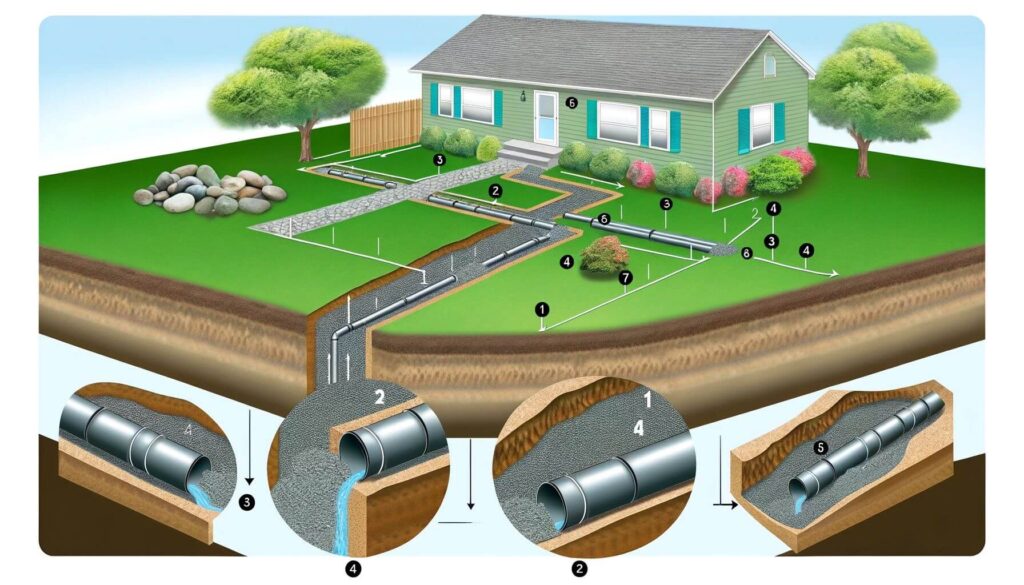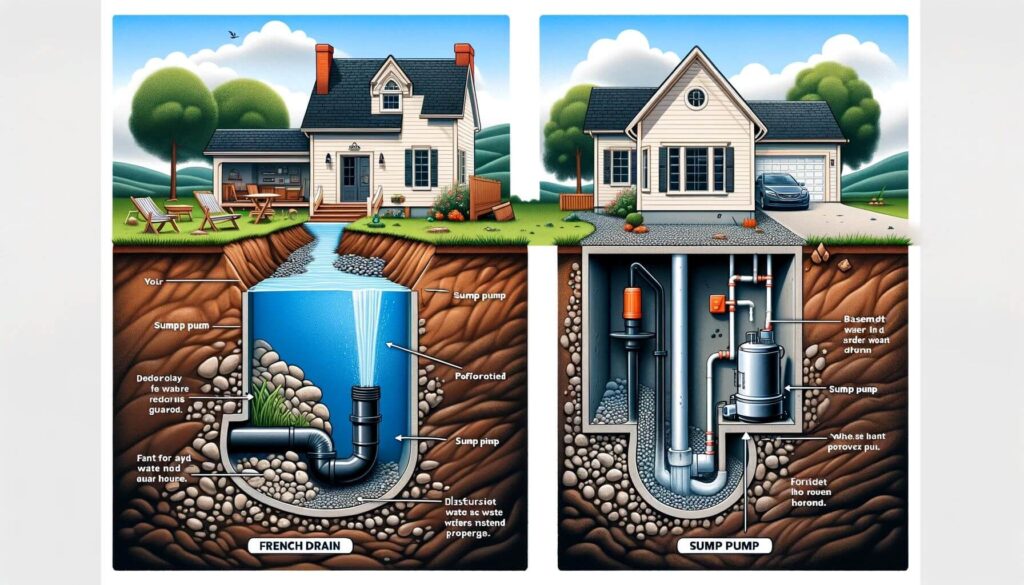
A French drain manages water at the surface level, diverting it away from your property to prevent pooling and erosion, while a sump pump removes water that has accumulated in a basement or crawlspace, protecting against flooding and moisture damage.
Managing Excess Water in Homes
Excess water can pose a significant risk to residential properties. It’s crucial to manage this water effectively to protect foundations, landscapes, and basements from damage. Solutions vary, but the goal remains the same: keep water away from where it can cause harm.
French Drain Design and Functionality?

A French drain is a trench filled with gravel or rock, containing a perforated pipe that redirects surface water and groundwater away from an area. It’s designed to prevent water from pooling in undesired locations by providing an easy pathway for the water to flow through the gravel and into the pipe, which then carries it away from the property.
Typical Applications and Benefits
French drains are ideal for preventing water accumulation around foundations, in gardens, and on lawns. They’re beneficial for areas prone to surface water pooling and can be integrated into landscape design seamlessly. The main advantages include reducing soil erosion, preventing basement flooding, and protecting structural integrity.
Potential Drawbacks or Limitations
While effective, French pump may require significant excavation and can be disrupted by root growth or sediment build-up, necessitating maintenance or repairs. They may not be suitable for all types of soil, particularly those with high clay content, which can hinder water flow.
What is a Sump Pump?
[amazon box=”B0CMZSRHJ6″] [/amazon]Components and Operation
A sump pump is an electrically powered device installed in a sump pit, a basin dug into the lowest part of a basement or crawlspace. When water fills the sump pit to a certain level, the sump pump activates, pumping water out of the pit and away from the property through a discharge pipe.
Ideal Use Cases and Advantages of Using Sum Pump without French Drain
Sump pumps are essential in areas prone to basement flooding or where the water table is above the foundation of a home. Sump pump without french drain offers immediate water removal, protecting against water damage and mold growth. Their ability to handle large volumes of water quickly makes them invaluable during heavy rainfall or snowmelt.
Possible Disadvantages or Considerations
The main drawbacks include reliance on electricity, which can be problematic during power outages, and the potential for mechanical failure. Regular maintenance is required to ensure reliability. Additionally, installation can be intrusive and may require professional assistance.
Key Differences Between Sump Pump French Drains
Operational Mechanisms
- French Drains work passively, using gravity to redirect surface and groundwater away from specific areas. They rely on a trench filled with gravel and a perforated pipe to facilitate water flow.
- Sump Pumps actively remove water that has accumulated in a sump pit. They are powered by electricity and kick into action when the water level triggers the pump, physically moving water away from the property.
Installation Locations and Processes of French Drain Sump Pump
- French Drains are installed underground, around the perimeter of a property or specific areas prone to water accumulation. The installation process involves digging a trench, laying the pipe, and filling it with gravel.
- Sump Pumps are installed in the lowest part of a basement or crawlspace, inside a sump pit. The process requires creating a pit, placing the pump, and ensuring proper discharge pipe placement.
Effectiveness in Different Scenarios Between French Drain Sump Pump
- French Drains pump are most effective in preventing water from reaching problematic areas, making them ideal for landscape management and protecting structures from surface water.
- Sump Pumps excel in situations where water has already entered a structure, such as a basement, offering a solution to remove this water and prevent damage.
These differences highlight the complementary nature of French drains and sump pumps, with each system offering unique benefits depending on the water management needs of a property.
Pros and Cons Sump Pump vs French Drain

French Drain Pros and Cons
Pros:
- Preventative Solution: French pump provide a proactive way to manage water, preventing it from accumulating and causing damage.
- Landscape Integration: They can be seamlessly integrated into your landscape, enhancing drainage without detracting from the aesthetic appeal.
- Versatile Applications: Suitable for a wide range of outdoor areas, including gardens, lawns, and around building foundations.
Cons:
- Installation Complexity: Requires significant excavation, which can be disruptive and may necessitate professional installation.
- Maintenance Needs: Over time, the system can become clogged with roots or sediment, requiring cleaning or repairs.
- Soil Specificity: May not function as effectively in certain types of soil, such as heavy clay.
Sump Pump Pros and Cons
Pros:
- Immediate Water Removal: Sump pumps quickly remove water that has accumulated in basements or crawlspaces, preventing damage.
- High-Capacity Pumping: Capable of handling large volumes of water, making them ideal for areas prone to flooding.
- Automatic Operation: Equipped with a float switch for automatic activation, providing peace of mind during heavy rains or snowmelt.
Cons:
- Dependence on Electricity: Requires electricity to operate, which can be a problem during power outages unless a backup system is in place.
- Mechanical Failure Risk: As mechanical devices, sump pumps are susceptible to failure, which could lead to flooding if not addressed.
- Maintenance and Testing: Regular maintenance is necessary to ensure reliability, including testing, cleaning, and replacing parts as needed.
Both French drains and sump pumps offer valuable solutions for managing water around properties. The choice between them or the decision to use both depends on specific needs, property characteristics, and potential water issues.
French Drain vs Sump Pump: What is the Right Solution

Factors to Consider Sump Pump vs French Drain
- Water Accumulation Source: Identify whether water is primarily coming from surface runoff or if it’s infiltrating your basement or crawl spaces from the ground.
- Property Layout: The slope of your property, the location of buildings, and existing landscaping can influence which system (or combination) will work best.
- Budget: Installation and maintenance costs for French drains and sump pumps can vary. Assess your budget to determine which solution or combination of solutions is financially feasible.
Assessing Your Needs
To choose the right water management solution, evaluate how water interacts with your property during heavy rainfalls or snow melts. Consider consulting with a professional who can offer insights based on your property’s specific characteristics and recommend the most effective strategy.
Combination of French Drain And Sump Pump System
Beneficial Scenarios
Using both French drain and sump pump can be advantageous in certain situations:
- High Water Table Areas: Homes with basements in high water table areas might need a sump pump for internal water management and a French drain to handle surface water.
- Comprehensive Water Management: In properties where water accumulation is a concern both at the surface and in sub-surface areas, combining the two systems ensures all bases are covered.
Complementary Benefits
- Preventative and Reactive Measures: A French drain pump acts as a preventative measure by redirecting surface water, while a sump pump offers a reactive solution to water that has already entered the structure.
- Enhanced Protection: Together, they provide a layered defense against water damage, effectively managing water at both the surface and foundation levels.
By considering the specific needs of your property and possibly combining the strengths of both a French drain and a sump pump, you can create a robust and efficient water management system. This dual approach ensures that your home remains dry and protected against potential water-related issues.
French Drain vs. Sump Pump
Managing water effectively is crucial to protecting your property from potential damage. French drains and sump pumps offer valuable solutions, each with its own set of benefits. French drains are excellent for preventing surface water accumulation, while sump pumps are essential for removing water that has infiltrated basements or crawl spaces.
Promptly addressing water management issues can save homeowners from costly repairs and extensive property damage. It’s important to assess your property’s specific needs, considering the source of water accumulation, the layout of your property, and your budget, to determine the most effective solution.
We encourage homeowners to consult with water management professionals. These experts can provide personalized advice, helping you choose the right system or combination of systems for your home. They can also offer installation guidance and maintenance tips to ensure your property remains protected for years to come.
FAQs Sump Pump French Drain
Q: How do I decide between a sump pump French drain ?
A: Consider the source of water accumulation. If it’s surface water, a French drain might be sufficient. For water entering your basement or crawl space, a sump pump is necessary. Many properties benefit from both.
Q: Can I install a French drain or sump pump myself?
A: While DIY installations are possible, professional installation ensures that the system works as intended and complies with local regulations. It’s particularly recommended for sump pump installations due to their complexity.
Q: How often should I maintain my French drain or sump pump?
A: Inspect and clean your French drain annually to prevent clogging. Test your sump pump regularly, especially before rainy seasons, and perform maintenance as recommended by the manufacturer.
Q: What is the lifespan of French Drain Sump pump systems?
A: With proper maintenance, French drains can last for decades. Sump pumps typically have a lifespan of around 10 years, but this can vary based on usage and maintenance.
Choosing the right water management solution is essential for protecting your property. By understanding the capabilities and limitations of French drains and sump pumps, you can make an informed decision that meets your needs and ensures your home stays dry and damage-free.



